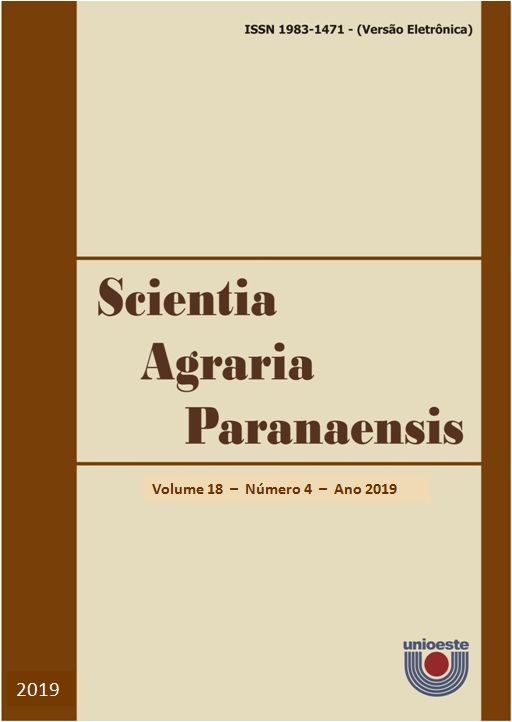Productivity of cassava grown on Marandu grass straw managed through diferent grazing intensities
DOI:
https://doi.org/10.18188/sap.v18i4.22845
Agências de fomento
Resumo
For cassava farming, conventional soil preparation is traditionally used. However, in recent years, some producers have been showing interest in adopting no-tillage system. We evaluated the cassava yield in conventional tillage or no-tillage systems with marandu grass straw, as well as the straw decomposition and the physical and chemical soil attributes. A completely randomized design with five treatments and four replicates was used. The treatments were no-tillage (NT 0% - no-grazing pasture; NT 25%, NT 50%, NT 75% - grazing intensities to obtain an intake of 25%, 50% and 75% of forage mass, by animals) and conventional tillage (CT 50% - grazing intensity to obtain an intake of 50% of forage mass, before tillage). The soil tillage did not influence fresh and dry weight of cassava roots, with averages of 31.84 and 10.88 Mg ha-1. After 448 days of cassava planting, straw decomposition did not differ between treatments, with an average value of 53%. The half-life time of straw was 221, 218, 263 and 321 days to treatments NT 0%, NT 25%, NT 50%, NT 75%, respectively. We observed that soil physical quality was improved in no-tillage treatment NT 50%, when compared to CT 50%. The residual straw of Marandu grass did not influence the cassava yield in no-tillage, when compared to conventional tillage. Part of the forage available in the pasture can be used for animal feed, before cassava planting.Downloads
Publicado
15-12-2019
Como Citar
GOBBI, K. F.; TAKAHASHI, M.; FIDALSKI, J. Productivity of cassava grown on Marandu grass straw managed through diferent grazing intensities. Scientia Agraria Paranaensis, [S. l.], p. 324–333, 2019. DOI: 10.18188/sap.v18i4.22845. Disponível em: https://e-revista.unioeste.br/index.php/scientiaagraria/article/view/22845. Acesso em: 24 dez. 2025.
Edição
Seção
Artigos Científicos
Licença
Aviso de Direito Autoral Creative Commons
Política para Periódicos de Acesso Livre
Autores que publicam nesta revista concordam com os seguintes termos:
1. Autores mantém os direitos autorais e concedem à revista o direito de primeira publicação, com o trabalho simultaneamente licenciado sob a Licença Creative Commons Attribution que permite o compartilhamento do trabalho com reconhecimento da autoria e publicação inicial nesta revista.2. Autores têm autorização para assumir contratos adicionais separadamente, para distribuição não-exclusiva da versão do trabalho publicada nesta revista (ex.: publicar em repositório institucional ou como capítulo de livro), com reconhecimento de autoria e publicação inicial nesta revista.
3. Autores têm permissão e são estimulados a publicar e distribuir seu trabalho online (ex.: em repositórios institucionais ou na sua página pessoal) a qualquer ponto antes ou durante o processo editorial, já que isso pode gerar alterações produtivas, bem como aumentar o impacto e a citação do trabalho publicado (Veja O Efeito do Acesso Livre).
Licença Creative Commons
Esta obra está licenciada com uma Licença Creative Commons Atribuição-NãoComercial-CompartilhaIgual 4.0 Internacional, o que permite compartilhar, copiar, distribuir, exibir, reproduzir, a totalidade ou partes desde que não tenha objetivo comercial e sejam citados os autores e a fonte.


